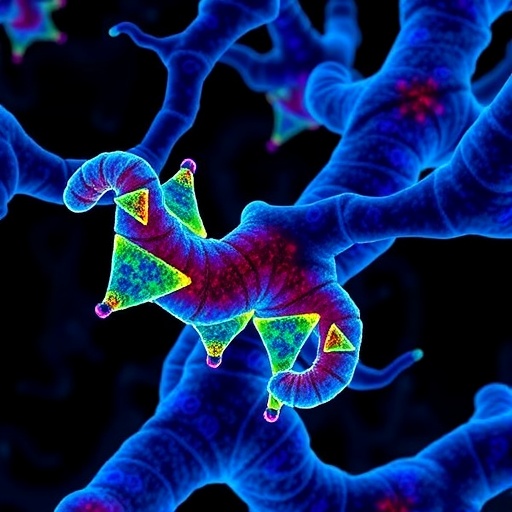
In a groundbreaking discovery poised to reshape our understanding of diabetic wound healing, researchers have identified a fundamental molecular mechanism that is disrupted in diabetes, offering new avenues for therapeutic intervention. The study reveals that advanced glycation end-products (AGEs), which accumulate excessively in diabetic tissues, interfere with a crucial phase separation process involving Galectin-3 and integrin α5β1, thereby impeding efficient wound repair in rodent models. This finding provides an unprecedented glimpse into the nuanced interplay between cellular adhesion molecules and pathological metabolic byproducts, cementing phase separation as a pivotal player in tissue regeneration dynamics under diabetic conditions.
For decades, diabetic wounds have presented a stubborn clinical challenge, notoriously resistant to conventional treatment and often culminating in severe complications, including infections and amputations. Despite intense research efforts, the precise molecular disruptions responsible for this impaired healing have largely remained elusive. This new investigation delves deeply into the biophysical properties of cellular proteins at wound sites, uncovering that phase separation—a process by which biomolecules spontaneously demix to form distinct membraneless compartments—is critical for coordinating the intricate cascade of cellular behaviors necessary for tissue repair.
Central to this process is Galectin-3, a β-galactoside-binding lectin widely implicated in cell adhesion, immune responses, and tissue remodeling. Under physiological conditions, Galectin-3 interacts intimately with integrin α5β1, a key transmembrane receptor that mediates cell-extracellular matrix adhesion and signaling. The new study reveals that these interactions are not random but are governed by a phase separation mechanism, allowing Galectin-3 and integrin α5β1 to cluster into dynamic assemblies at the wound milieu. These assemblies orchestrate crucial signaling hubs that promote cell migration, proliferation, and extracellular matrix deposition, all essential steps for effective wound closure.
.adsslot_HQms0rEPBt{width:728px !important;height:90px !important;}
@media(max-width:1199px){ .adsslot_HQms0rEPBt{width:468px !important;height:60px !important;}
}
@media(max-width:767px){ .adsslot_HQms0rEPBt{width:320px !important;height:50px !important;}
}
ADVERTISEMENT
However, in diabetic environments, this delicate equilibrium is perturbed by the pathological accumulation of AGEs. These molecules are the result of non-enzymatic glycation of proteins, lipids, and nucleic acids due to chronic hyperglycemia. AGEs are notorious for eliciting tissue stiffness, oxidative stress, and inflammation. The latest research uncovers a novel injurious role for AGEs: their direct interference with the phase separation of Galectin-3 and integrin α5β1 complexes. By binding to these proteins or altering their local environment, AGEs thwart the formation of functional condensates, leading to impaired cellular adhesion and signaling at wound sites.
The team employed cutting-edge cellular imaging and biophysical assays to visualize and quantify the assembly of Galectin-3 and integrin α5β1 complexes. Using rodent models genetically engineered to mimic the diabetic state, they demonstrated that disrupting the formation of these phase-separated assemblies correlates strongly with slowed wound healing and compromised tissue integrity. Notably, they were able to rescue the impaired healing phenotype by pharmacologically targeting AGE accumulation, thereby restoring proper phase separation dynamics and downstream signaling.
This compelling evidence firmly establishes phase separation as a previously unrecognized regulatory layer in diabetic wound pathology. The study’s implications extend beyond wound healing: it paints a broader picture of how post-translational modifications and metabolic byproducts can disrupt biophysical protein interactions, thereby modulating cellular function in disease contexts. The concept of phase separation has revolutionized cell biology over the past decade, but its connection to chronic metabolic disorders is only beginning to be explored.
Furthermore, these insights provide a molecular rationale for longstanding clinical observations linking poor glycemic control with delayed wound closure. By pinpointing the molecular culprit—AGE interference with Galectin-3-integrin condensates—the research opens potential therapeutic avenues aimed at restoring or mimicking these phase-separated compartments. For instance, small molecules or peptides designed to stabilize Galectin-3 and integrin interactions or inhibitors that prevent AGE formation could revolutionize treatment modalities for diabetic ulcers and other chronic wounds.
The study also highlights the importance of the extracellular matrix context in modulating phase separation events. Integrin α5β1, a primary receptor for fibronectin, anchors cells to their surrounding matrix, allowing them to sense and respond to biochemical and mechanical cues. The disruption caused by AGEs likely alters not only protein-protein interactions within cells but also the cell-matrix adhesion landscape, compounding the challenges cells face during tissue repair. Future investigations may unravel the feedback loops between extracellular modifications and intracellular condensate dynamics.
Importantly, the research underscores the necessity of interdisciplinary approaches combining biophysics, molecular biology, and disease modeling to unravel complex pathological mechanisms. By integrating live-cell imaging, protein chemistry, and diabetic rodent models, the authors constructed a comprehensive framework linking molecular condensates to tissue-level outcomes. Such integrative strategies are crucial to translate fundamental biophysical phenomena into actionable biomedical insights.
Intriguingly, Galectin-3 has been implicated in numerous pathological conditions beyond diabetes, including cancer metastasis and fibrosis. Its capacity to undergo phase separation with integrins may represent a generalizable mechanism for organizing cell-matrix interactions across diverse biological processes. The specific vulnerability of these condensates to AGE modification may thus have relevance in other chronic diseases characterized by oxidative stress and protein glycation.
The authors also addressed the temporal dynamics of these phase-separated condensates during the wound healing process. Their observations indicate that the formation and dissolution of Galectin-3-integrin ensembles are tightly regulated, corresponding to distinct phases of cellular migration and extracellular matrix remodeling. Disruption by AGEs causes prolonged or incomplete condensate formation, which may stall cellular progression through the healing stages, resulting in chronic wound states typically observed in diabetic patients.
At the cellular signaling level, the disassembly of Galectin-3-integrin condensates was shown to impair downstream pathways involving focal adhesion kinase (FAK) and extracellular signal-regulated kinase (ERK), both crucial for cell motility and survival. This mechanistic insight provides tangible targets for intervention, as pharmacological modulation of these signaling axes might compensate for defective phase separation and enhance wound resolution.
Another notable breakthrough is the potential reversibility of the impaired condensate formation. The research demonstrated that treatment with AGE inhibitors not only halts further damage but partially restores the ability of Galectin-3 and integrin α5β1 to phase separate. This finding offers hope for therapeutic windows during which intervention can rescue or improve healing outcomes, especially if detected early in the diabetic wound progression.
Looking forward, this research invites further exploration into other glycated proteins that might interfere with phase separation-dependent cellular functions. The concept that metabolic dysfunction exerts wide-reaching effects through the alteration of biomolecular condensates could redefine disease paradigms and inspire innovative drug discovery programs targeting condensate biophysics.
In conclusion, the elucidation of Galectin-3-integrin α5β1 phase separation as a critical regulator of diabetic wound healing, and its disruption by AGEs, represents a major advance in the field of regenerative medicine and metabolic disease research. By linking a biophysical property of proteins to clinical pathology, the study bridges fundamental biology with translational potential. This novel mechanistic insight not only deepens our understanding of diabetic complications but also lights a path toward more effective treatments for the millions suffering from impaired wound healing worldwide.
Subject of Research: Diabetic wound healing impairment due to disruption of protein phase separation by advanced glycation end-products.
Article Title: Galectin-3-integrin α5β1 phase separation disrupted by advanced glycation end-products impairs diabetic wound healing in rodents.
Article References:
Zhang, Z., Zhao, Z., Huang, X. et al. Galectin-3-integrin α5β1 phase separation disrupted by advanced glycation end-products impairs diabetic wound healing in rodents. Nat Commun 16, 7287 (2025). https://doi.org/10.1038/s41467-025-62320-w
Image Credits: AI Generated
Tags: advanced glycation end productsbiophysical properties of cellular proteinscellular adhesion molecules in healingdiabetic complications in wound healingdiabetic wound healingGalectin-3 disruptionintegrin α5β1 impairmentmembraneless compartments in biologymolecular mechanisms in diabetesphase separation in tissue repairtherapeutic interventions for diabetic woundstissue regeneration dynamics in diabetes





